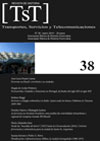Summary - TST 38
TRANSPORTES, SERVICIOS Y TELECOMUNICACIONES

Stefano MAGGI
Railways and urbanistic development in Italy. The railway small cities between Siena and Follonica in Tuscany 1859-1961
[Download the complete article in pdf format]
<<< SUMMARY TST 38
[ Abstract ]
During the XIXth century, the railway brought the greatest
changes, since Italy has a largely hilly and mountainous
territory. Even in the ancient port cities, the tracks were
spread from the docks to the limits of the built-up areas and
large maritime stations were built that moved the goods, also
contributing to urban growth. In the countryside, the railway
tracks along the river valleys attracted the residents of the
medieval centers on the hills, and new settlements were built
around the stations, the so-called “paesi scalo” (railway
countries).
The train station was something completely new compared to the
old post stations, which were in the heart of the cities and
integrated into the historic centers. Since the 1840s, the main
Italian cities underwent an urban change, caused by the
construction of the head or transit stations.
This paper analyzes the location of the stations in two Italian
towns, a Mediaeval town and a port town, Siena and Follonica. It
also focuses on the role of the changes, along the railway
itinerary Siena-Follonica, which had a fundamental role of
attraction towards the plains for the inhabitants of the hills.
The railway was also important in the fight against “malaria”
endemic disease.